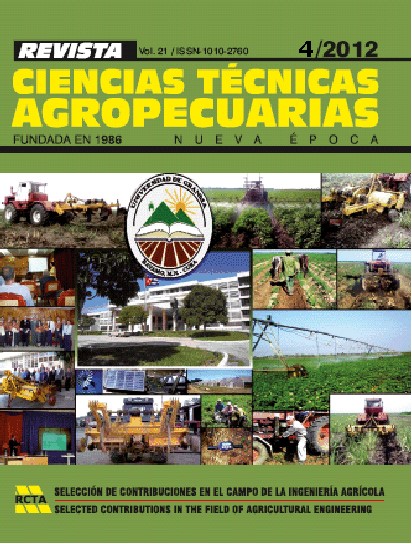Simulación Numérica de la Interacción Suelo-Apero Mediante el Método de Elementos Discretos
Main Article Content
Abstract
El mismo se basa en la acción que ejercen las fuerzas normal, tangencial, cohesión y fricción en un medio granular cohesivo, a partir de su
determinación a escala micro-mecánicas. Las propiedades macroscópicas que intervienen en el contacto suelo-suelo sirven como parámetros
macros los cuales son usados para determinar los parámetros micros del modelo. Para la simulación de la labranza se realizó la generación
virtual de un bloque de suelo con un total de 45 000 partículas esféricas, formando un bloque cohesivo. Para verificar los resultados de la
simulación se acondicionó un canal de suelo para dos condiciones extremas: seco-endurecido y húmedo-suelto. Los resultados mostraron una
tendencia del modelo a sobreestimar la magnitud de la fuerza de tiro para el suelo suelto y con alta humedad, Sin embargo el modelo resultó
más preciso para la condición de alta densidad. Se obtuvieron además las distribuciones de densidad del suelo en las diferentes secciones del
bloque virtual así como los resultados de la distribución de fuerzas en las capas comprimidas debido al paso de la herramienta de labranza.
Article Details
Those authors that have publications with this journal accept the following terms:
1. They will retain their copyright and guarantee the journal the right of first publication of their work, which will be simultaneously subject to the License Creative Commons Attribution-NonCommercial 4.0 International (CC BY-NC 4.0) that allows third parties to share the work whenever its author is indicated and its first publication this journal. Under this license the author will be free of:
• Share — copy and redistribute the material in any medium or format
• Adapt — remix, transform, and build upon the material
• The licensor cannot revoke these freedoms as long as you follow the license terms.
Under the following terms:
• Attribution — You must give appropriate credit, provide a link to the license, and indicate if changes were made. You may do so in any reasonable manner, but not in any way that suggests the licensor endorses you or your use.
• NonCommercial — You may not use the material for commercial purposes.
• No additional restrictions — You may not apply legal terms or technological measures that legally restrict others from doing anything the license permits.
2. The authors may adopt other non-exclusive license agreements to distribute the published version of the work (e.g., deposit it in an institutional telematics file or publish it in a monographic volume) whenever the initial publication is indicated in this journal.
3. The authors are allowed and recommended disseminating their work through the Internet (e.g. in institutional telematics archives or on their website) before and during the submission process, which can produce interesting exchanges and increase the citations of the published work. (See the Effect of open access).
